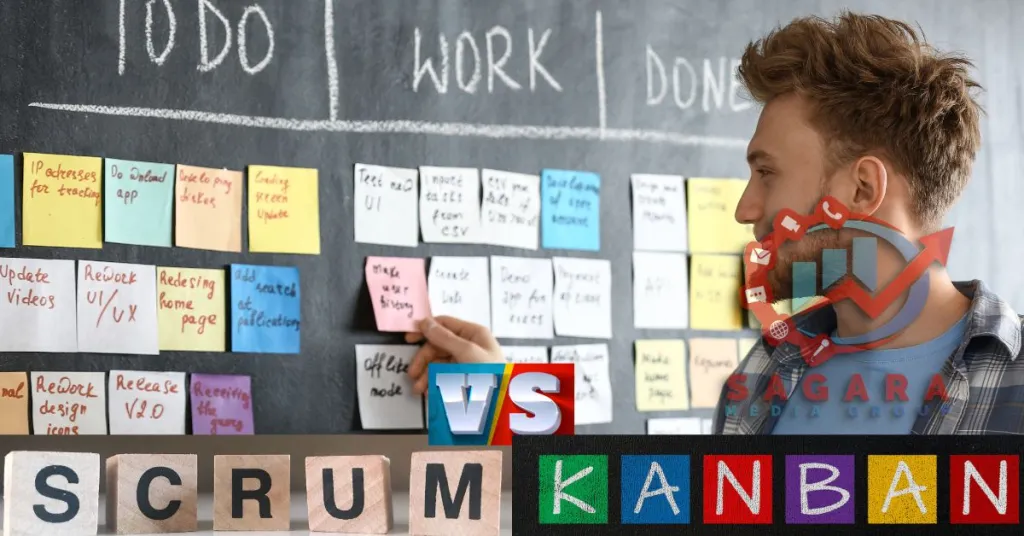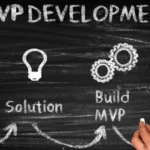Agile Methodology:
When to Use Kanban and When to Use Scrum
Agile methodology is a set of values and principles that guide software development teams to deliver high-quality products that meet customer needs. Agile teams work in short iterations, collaborate frequently, and adapt to changing requirements. There are many agile frameworks that implement agile methodology, such as Scrum and Kanban. In this blog post, we will compare these two frameworks and help you decide when to use Kanban and when to use Scrum for your projects.

What is Kanban?
Kanban is a project management framework that relies on visual tasks to manage workflows. Kanban originated from the Toyota Production System, which used cards (kanbans) to signal the demand and supply of materials in a factory. Kanban helps teams optimize their flow of work by limiting the amount of work in progress (WIP) and making the work visible on a Kanban board. A Kanban board consists of columns that represent different stages of the workflow, such as To Do, In Progress, and Done. Each column has a WIP limit that indicates how many tasks can be done in that stage at any time. Tasks are represented by cards that move from left to right across the board as they are completed.
The main benefits of Kanban are:
- It reduces waste and inefficiency by focusing on the value stream and eliminating bottlenecks.
- It improves quality and customer satisfaction by delivering work faster and more frequently.
- It enhances team collaboration and communication by making the work transparent and visible to everyone.
- It fosters continuous improvement by encouraging teams to monitor their performance and experiment with new ideas.
The main challenges of Kanban are:
- It requires a high level of discipline and commitment from the team to follow the rules and respect the WIP limits.
- It may not provide enough structure and guidance for complex or uncertain projects that need more planning and coordination.
- It may not suit teams that have fixed deadlines or scope requirements, as Kanban does not prescribe timeboxes or deliverables.
What is Scrum?
Scrum is a project management framework that helps teams’ structure and manage their work through a set of values, principles, and practices. Scrum is based on the empirical process control theory, which states that knowledge comes from experience and making decisions based on what is known. Scrum enables teams to deliver valuable products incrementally and iteratively by inspecting and adapting their work at regular intervals.
The main components of Scrum are:
- The Scrum Team, which consists of a Product Owner, a Scrum Master, and Developers. The Product Owner is responsible for maximizing the value of the product and managing the Product Backlog. The Scrum Master is responsible for facilitating the Scrum process and coaching the team. The Developers are responsible for creating a potentially releasable product increment in each Sprint.
- The Product Backlog, which is an ordered list of all the features, requirements, enhancements, and fixes that constitute the product. The Product Owner prioritizes the Product Backlog items (PBIs) according to their value, risk, dependency, and urgency.
- The Sprint, which is a timeboxed period of one month or less, during which the team creates a product increment that meets the Definition of Done. Each Sprint starts with a Sprint Planning meeting, where the team selects the PBIs from the Product Backlog that they can complete in the Sprint. Each Sprint ends with a Sprint Review meeting, where the team presents the product increment to the stakeholders and collects feedback, and a Sprint Retrospective meeting, where the team reflects on their performance and identifies improvement actions.
- The Sprint Backlog, which is a subset of the Product Backlog items that the team commits to deliver in the Sprint. The Sprint Backlog also includes a plan for how the team will accomplish their work.
- The Daily Scrum, which is a 15-minute meeting held every day during the Sprint, where each team member answers three questions: What did I do yesterday? What will I do today? Are there any impediments in my way?
- The Increment, which is the sum of all the PBIs completed during a Sprint and all previous Sprints. The Increment must be usable, valuable, and adhere to the Definition of Done.
The main benefits of Scrum are:
- It increases customer satisfaction and business value by delivering working products frequently and incorporating feedback.
- It enhances team productivity and creativity by empowering them to self-organize and collaborate.
- It reduces risk and uncertainty by breaking down complex projects into manageable chunks and inspecting and adapting them regularly.
- It fosters continuous improvement by encouraging teams to learn from their experiences and improve their processes.
The main challenges of Scrum are:
- It requires a high level of trust and collaboration among the team members and stakeholders.
- It may not fit well with organizations that have rigid hierarchies, silos, or cultures that resist change.
- It may not suit projects that have fixed specifications or contracts, as Scrum embraces change and emergent requirements.
When to Use Kanban and When to Use Scrum?
There is no definitive answer to this question, as both Kanban and Scrum have their strengths and weaknesses, and the best framework for your project depends on various factors, such as:
- The nature of the work: Is it predictable or unpredictable? Is it simple or complex? Is it urgent or not?
- The type of product: Is it new or existing? Is it stable or evolving? Is it customer-facing or internal?
- The characteristics of the team: How large is it? How experienced is it? How distributed is it? How autonomous is it?
- The expectations of the stakeholders: What are their goals and priorities? What are their feedback and communication preferences? What are their quality and delivery standards?
Generally speaking, Kanban may be more suitable for projects that:
- Have a continuous and steady flow of work that does not require much planning or estimation.
- Have a mature and stable product that requires minimal changes or enhancements.
- Have a small and co-located team that has a high level of expertise and discipline.
- Have flexible and responsive stakeholders that value speed and quality over scope and schedule.
On the other hand, Scrum may be more suitable for projects that:
- Have a variable and uncertain flow of work that requires frequent planning and re-prioritization.
- Have a new and evolving product that requires significant changes or innovations.
- Have a large and distributed team that needs a clear structure and guidance.
- Have demanding and involved stakeholders that value feedback and collaboration over cost and contract.
However, these are not hard-and-fast rules, and you may find that your project can benefit from both Kanban and Scrum practices. In fact, many teams use a hybrid approach called Scrumban, which combines the best of both worlds. Scrumban allows teams to use the Scrum framework as a backbone, while applying the Kanban principles of visualization, WIP limits, and flow optimization. Scrumban can help teams transition from Scrum to Kanban, or vice versa, or simply improve their existing processes.
How Can Agile Methodology Help You Succeed in Your Projects?
Agile methodology can help you succeed in your projects by enabling you to:
- Deliver value to your customers faster and more frequently.
- Adapt to changing requirements and market conditions.
- Improve the quality of your products and processes.
- Enhance the collaboration and satisfaction of your team and stakeholders.
Whether you choose Kanban, Scrum, or any other agile framework, the key is to embrace the agile mindset of customer-centricity, experimentation, inspection, adaptation, and improvement. By doing so, you can create products that delight your customers and make a positive impact on your organization.
[Sources: 1](https://www.atlassian.com/agile/kanban/kanban-vs-scrum), [2](https://www.atlassian.com/agile/kanban), [3](https://asana.com/resources/scrumban), [4](https://www.brightwork.com/blog/agile-methodologies-scrum-and-kanban)


